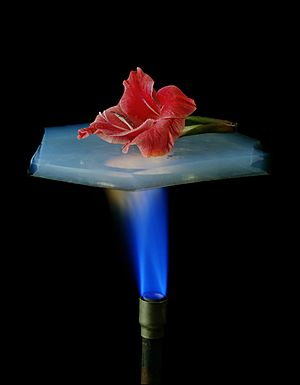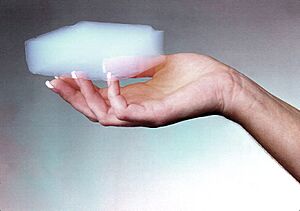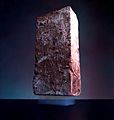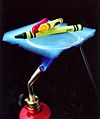Aerogel facts for kids
Aerogel is a super-light material that feels like a solid, even though it's mostly empty space! Imagine a gel (like jelly), but instead of liquid inside, it has gas (usually air). It was created in 1931 by Samuel Stephens Kistler.
The most common type is called silica aerogel, which is made from the same stuff as glass. It's so light that it's almost like holding air! In fact, it's known as the world's lightest solid material. Aerogel can handle very high heat, melting only at 1200 degrees Celsius. It's also an amazing heat blocker, better than most other materials. This means it can keep things warm or cold very well.
Even though aerogel is great at blocking heat, it can be expensive. It's also a bit fragile and can break easily, like glass. Most types don't like water, and even a little bit can damage them. But don't worry, it's safer than some other old insulation materials because it's not known to cause health problems if you breathe it in.
Contents
What Makes Aerogel Special?
Even though it's called "aerogel," it's actually a dry, stiff solid. It doesn't feel like jelly at all! If you press on it gently, it won't leave a mark. If you press harder, it might get a dent. But if you press really hard, it can shatter like glass. Newer types are stronger and don't break as easily.
Aerogel is incredibly strong for how light it is. This is because it's made of tiny, tiny particles (about 2 to 5 nanometers wide) that are linked together in a complex, tree-like structure. This structure has lots of tiny holes, or pores, that are smaller than 100 nanometers.
Most aerogel is made of 90% to 99.8% air! Think of it like a sponge with super tiny holes filled with air. This makes it very light and helps it block heat.
How Aerogel Blocks Heat
Aerogels are fantastic heat blockers because they stop heat in two main ways:
- Conduction: Heat usually travels through materials. But aerogels are mostly air, and air is very bad at conducting heat. So, heat can't easily move through the material itself.
- Convection: This is when heat moves through liquids or gases that are flowing. The tiny, tiny holes in aerogel trap the air, so it can't move around. This stops heat from traveling by air currents.
However, aerogels aren't great at blocking thermal radiation (heat that travels as light, like from the sun). Infrared light, which carries heat, can pass right through them.
Why Aerogel Feels Dry
Aerogel loves to absorb moisture from the air. This is why it feels very dry to the touch. If you handle it for a long time without gloves, your skin might feel dry and brittle.
The Colors of Aerogel
Aerogel often looks a bit smoky blue when it's against a dark background, and yellowish when it's against a bright background. This happens because of how light bounces off its super tiny structure. It's similar to why the sky looks blue!
Keeping Aerogel Dry
Normally, aerogels absorb water and can get damaged or shrink. But scientists can treat them with chemicals to make them "hydrophobic" (water-repelling). This helps them last much longer, even if they get a little wet.
How Is Aerogel Used?
Aerogels are used in many cool ways because of their special properties:
- Super Insulation: They are great for keeping buildings warm or cool. For example, aerogel insulation boards can be half as thick as regular insulation but work just as well! They've been used in special windows and even in a solar-powered house project.
- Cleaning Up Spills: Because they have a huge surface area and can repel water while absorbing other things, silica aerogels can help clean up spills, like removing heavy metals from dirty water.
- Cooling Surfaces: They can be used in special surfaces that help cool things down naturally, even in sunlight.
- Helping Chemical Reactions: Aerogels can act as a catalyst, which speeds up chemical reactions, or help carry other catalysts.
- In Tech Gadgets: They are used in some imaging devices, optics, and light guides.
- Thickening Agent: You might find them in some paints and even cosmetics to make them thicker.
- Energy Absorbers: They can be used in things that need to absorb energy.
- Space Exploration: NASA has used aerogel to catch tiny pieces of cosmic dust from space aboard the Stardust spacecraft. These dust particles are so small they would just vaporize on impact with other materials, but they get trapped safely in aerogel. NASA also used aerogel to insulate the Mars rovers!
- Special Clothing: Aerogel can be made into flexible "blankets" or added to clothing, like for divers or in space suits, to keep people warm.
- Sports Gear: Some sports equipment, like tennis racquets, use aerogel to make them stronger.
- Water Cleaning: Special types of aerogels can help clean water by absorbing harmful metals like mercury or lead, separating oil from water (useful for oil spills!), and even killing bacteria.
- Aircraft De-icing: A new idea uses carbon nanotube aerogel to prevent ice from forming on airplane wings. It's super light and can be left on at low power.
- Soundproofing: Silica aerogels can also help block sound, making them useful for quiet windows or building walls.
- Supercapacitors: Carbon aerogels are used in tiny, powerful energy storage devices called supercapacitors. These can be much smaller than regular capacitors and can store and release energy very quickly.
- Fusion Research: Aerogels are used in Inertial Confinement Fusion (ICF) experiments. They help create special targets that allow scientists to control the fuel for fusion reactions.
Is Aerogel Safe?
Silica aerogels are not known to cause cancer or be poisonous. However, they can be a bit irritating. If you get them on your skin, in your eyes, or breathe in fine dust from them, they can cause dryness or irritation. So, it's a good idea to wear gloves, eye goggles, and a mask if you're handling bare aerogel, especially if dust might be created.
Images for kids
-
A 2.5 kg brick is supported by a piece of aerogel with a mass of 2 g.
-
Peter Tsou with a sample of aerogel at the Jet Propulsion Laboratory, California Institute of Technology.
See also
 In Spanish: Aerogel para niños
In Spanish: Aerogel para niños











